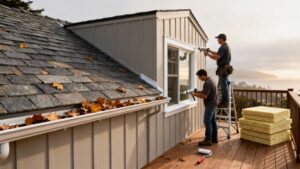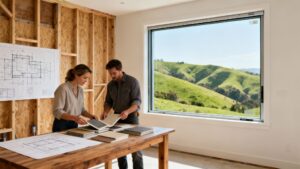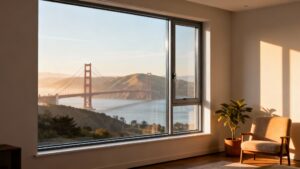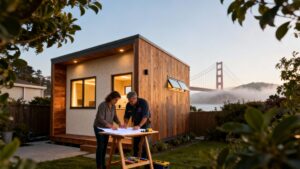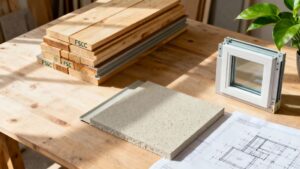Choosing replacement windows is a big decision for your home. It's about more than just looks. When done right, it's a smart investment in your Bay Area home's comfort and value. This guide will help you understand the key factors so you can make a choice like a pro.
Your Guide to Choosing the Perfect Replacement Windows
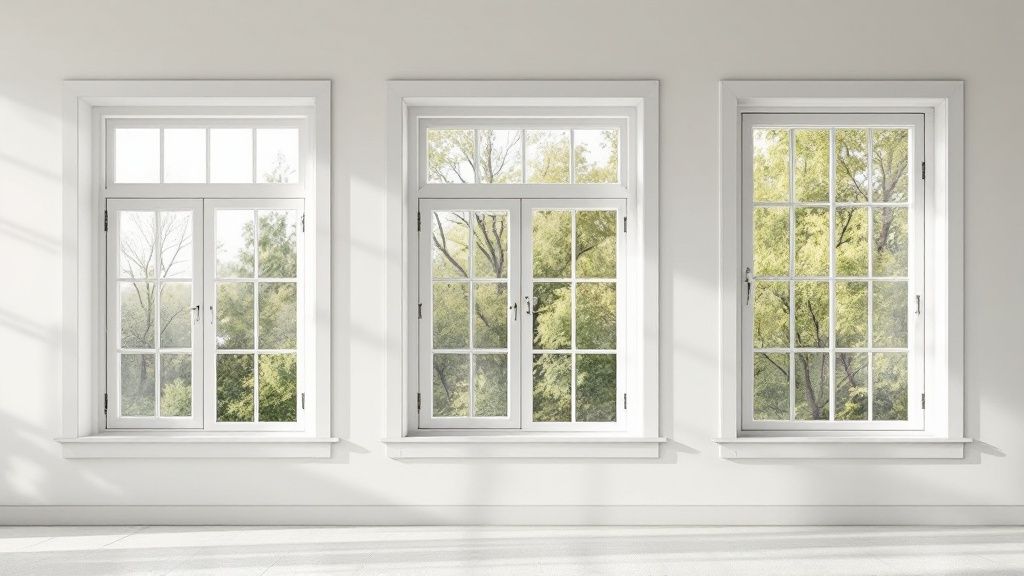
Alt text: A modern living room with large, clear replacement windows overlooking a lush, green backyard.
New windows are a serious investment. For homeowners and builders in Berkeley, Oakland, and across the Bay Area, this choice affects everything from your PG&E bill to how your home handles our coastal climate. It's easy to feel lost with so many options, but this guide will simplify the process.
We will walk you through the most important factors. This includes matching frame materials to your home's style, whether it’s a historic San Francisco Victorian or a modern Berkeley home. We'll also explain glazing technologies that make a real difference on foggy mornings and sunny afternoons.
Key Considerations for Bay Area Projects
Knowing how to read an energy label is very important. Here in California, windows must meet some of the strictest building codes in the country. The right windows save you money and prevent project delays.
Here is what you need to focus on:
- Energy Efficiency: Look for a low U-Factor and the right Solar Heat Gain Coefficient (SHGC). These two numbers are key for managing the Bay Area's mixed climate.
- Material Durability: Our climate includes moisture, salt air, and temperature swings. You need materials like fiberglass or aluminum-clad wood that can handle these conditions.
- Architectural Style: Your windows should match your home's design. The right choice will preserve its character and increase its value.
- Local Code Compliance: This is very important. Partner with experts who understand Berkeley and Oakland's specific energy and safety rules.
By focusing on performance and local needs, you are making a strategic upgrade. The right choice enhances comfort and strengthens your property's value.
For more information, you can read this resource on choosing the right windows and doors for extensions and renovations.
Our team has also created specific insights for our community. Learn more about expert Bay Area window replacement to start your project.
Matching Window Frame Materials to Your Home
The window frame provides the structure for your new window. It affects durability, maintenance, and the overall look. This makes it one of the most important decisions you'll make.
In the Bay Area, with its diverse architecture, the right material makes a big difference. A material for a historic home in San Francisco is different from one for a modern home in Berkeley. Your choice should align with your home's style, your budget, and the amount of maintenance you are willing to do.
This helpful infographic breaks down the key energy ratings on a modern window label. It's a great visual guide.
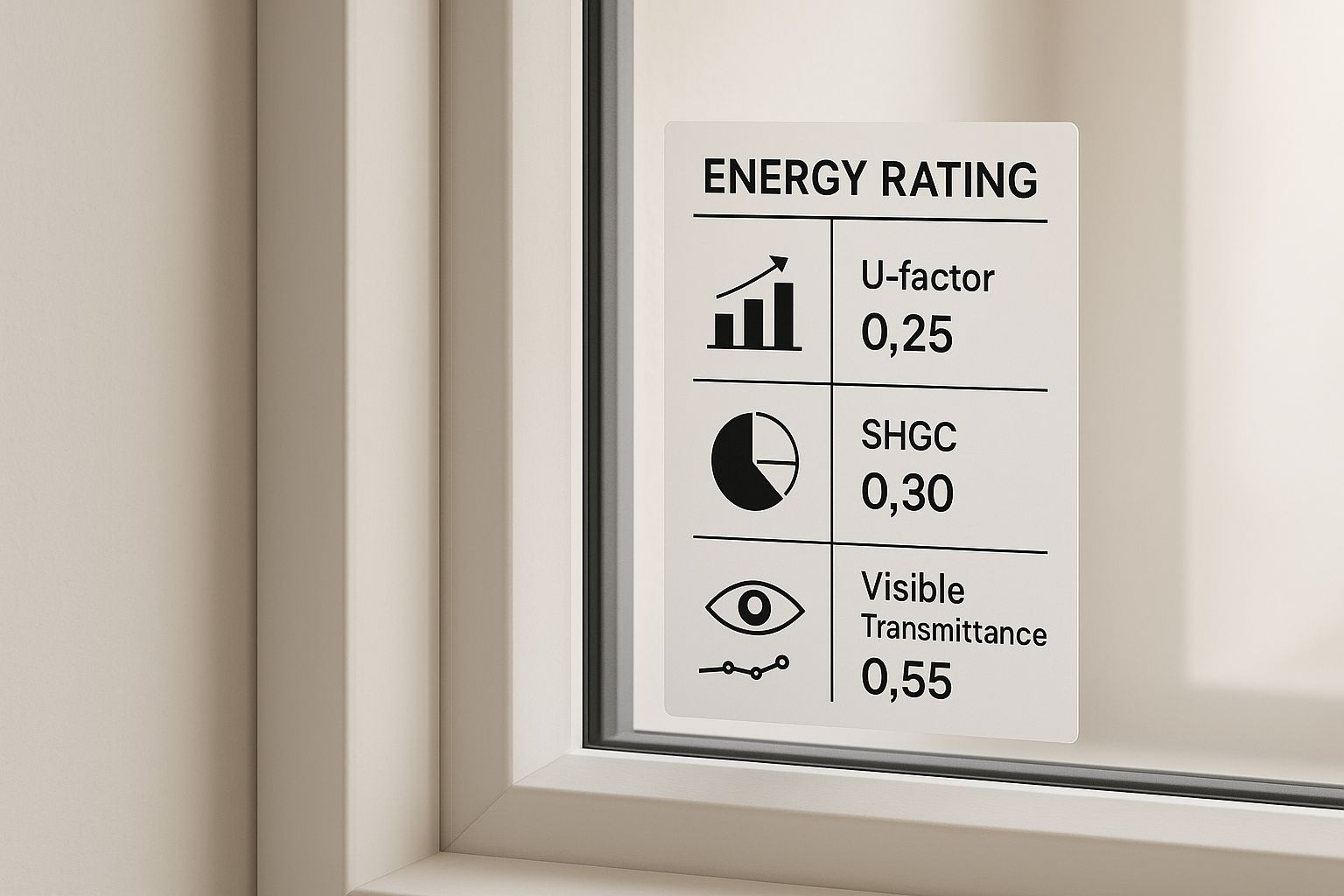
Alt text: Infographic showing key energy rating metrics for replacement windows.
Getting familiar with these ratings on the NFRC label is the first step toward picking a window that performs well in the Bay Area's climate.
Common Frame Materials for Bay Area Homes
Let's look at the most popular frame materials used by local builders and remodelers. Each material has different benefits for different projects.
-
Wood: Wood frames have a classic beauty, perfect for historic homes. They are great insulators but need regular maintenance to prevent moisture damage, which is important in our foggy climate. Some modern options use engineered wood for better stability. You can learn more about what is engineered wood in our guide.
-
Clad-Wood: This is a popular hybrid option in the Bay Area. You get a beautiful wood interior with a durable, low-maintenance aluminum or vinyl shell outside. It’s the best of both worlds: style inside and protection from the weather outside.
-
Fiberglass: If you live near the coast, fiberglass is a great choice. It is strong and durable, holding up well to salt air and high winds. These frames don't expand or contract much with temperature changes, creating a tight, energy-efficient seal.
-
Vinyl: Vinyl is a cost-effective and low-maintenance option. It is a practical choice for many projects, like rental properties in Oakland. Today's vinyl windows offer good energy performance and never need to be painted.
Comparing Top Window Frame Materials
Choosing a material can be tough. This simple table helps you compare the main options.
| Material | Pros | Cons | Best For |
|---|---|---|---|
| Wood | Classic, high-end look; excellent insulator; can be painted or stained | Requires regular maintenance; can be susceptible to rot and insects | Historic homes, custom designs, and achieving a traditional aesthetic |
| Clad-Wood | Wood interior appeal with a durable, low-maintenance exterior | Higher cost than vinyl or fiberglass; exterior finish can't be changed | Homeowners who want the beauty of wood without the exterior upkeep |
| Fiberglass | Extremely strong and durable; minimal expansion/contraction; low maintenance | Higher initial cost; fewer color options than other materials | Coastal areas, extreme climates, and projects where longevity is the top priority |
| Vinyl | Affordable; excellent energy efficiency; virtually no maintenance required | Limited color choices (mostly white/tan); can look less premium than other options | Rental properties, budget-friendly renovations, and standard-sized replacements |
This comparison shows the trade-offs between looks, performance, and cost. There is no single "best" material, only the one that is best for your project.
Making the Right Choice for Your Project
So, which material should you pick? It depends on your priorities. A contractor managing a rental property might choose low-cost, low-maintenance vinyl. An architect designing a custom home with large glass walls will likely choose strong fiberglass or aluminum frames.
Our advice at Truitt & White is to think long-term. Consider how the material will perform over decades. Durability and climate suitability are just as important as appearance.
Choosing the right frame material is a balance of looks, durability, maintenance, and budget. By weighing these factors, you’ll find a window that looks great and performs well for years.
Navigating Glass Options for Ultimate Comfort
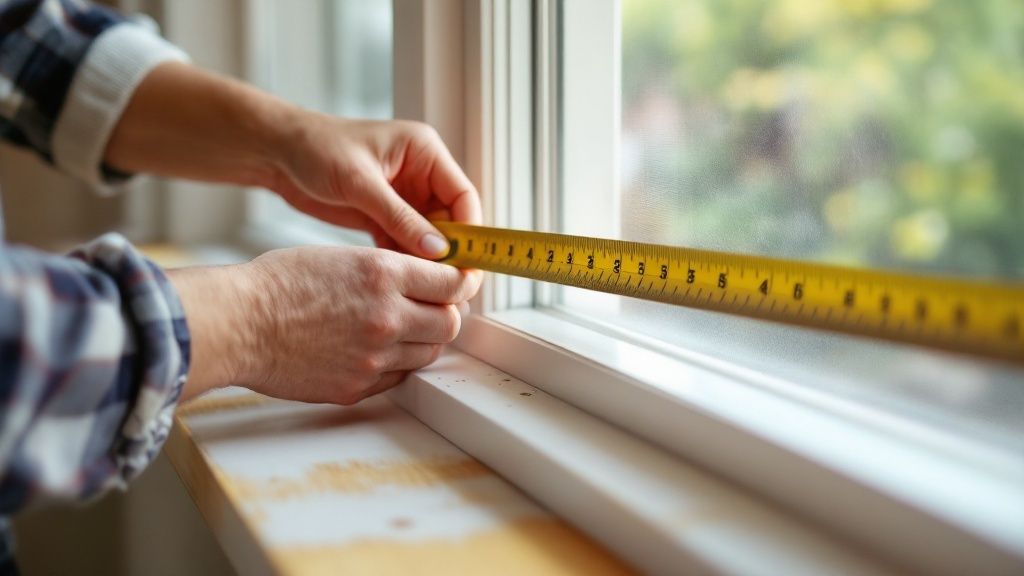
Alt text: A close-up view of a double-pane window, showing the spacer and seal between the two panes of glass.
The frame provides the window's structure, but the glass (or glazing) is where the real work of energy efficiency happens. Choosing the right glazing is key to a comfortable home and lower energy bills.
Today’s windows use multiple panes of glass, special coatings, and insulating gases. For the Bay Area, this technology is a game-changer. Our weather can go from a chilly, foggy morning to a hot, sunny afternoon on the same day.
The push for better window tech is a big deal. The insulating glass window market was valued at USD 14.5 billion in 2024 and is expected to grow. This growth is driven by demand for more energy-efficient buildings. Understanding the advantages of energy-efficient double glazed windows is a great place to start.
Understanding Glazing Technologies
To choose windows like a pro, you need to know the terms. These are the key parts of a modern window that improve insulation, reduce noise, and block UV rays.
Here’s a quick rundown:
- Double-Pane or Triple-Pane Glass: This is the standard for good reason. Two or three panes of glass are separated by a spacer. This traps a layer of air or gas, which acts as an insulator to slow heat transfer and reduce noise.
- Low-E (Low-Emissivity) Coatings: A Low-E coating is an invisible, heat-reflecting shield. In winter, it keeps warmth inside. In summer, it reflects the sun's heat away. Different coatings are designed for different climates.
- Argon or Krypton Gas Fills: The space between the glass panes is often filled with a harmless gas like argon or krypton. These gases are denser than air. They provide a better thermal barrier and improve the window's energy performance.
Putting It All Together for the Bay Area
What does this mean for your project? Imagine a west-facing window in a Berkeley home that gets a lot of afternoon sun. An old window would let all that heat in, making the room too hot and forcing your AC to work harder.
By choosing a window with a special Low-E coating designed to block solar heat gain, you can keep that room much cooler without losing natural light. This choice leads to lower energy bills and a more comfortable home.
This also works for noise reduction. If you are renovating a house near a busy road, upgrading to double-pane or triple-pane windows can create a peaceful indoor space. The extra pane and insulating gas help block sound waves.
For security options, check out our guide on hurricane impact glass.
Making Sense of Energy Performance Ratings
When choosing replacement windows, the energy performance label is very helpful. This sticker from the National Fenestration Rating Council (NFRC) contains important information. Understanding these numbers is key to choosing a window that will perform well in the Bay Area.
These ratings are also tied to local building codes. The California Energy Commission and ENERGY STAR use this data to set standards for our climate zones. Picking a window that meets these requirements helps your Berkeley or Oakland project pass inspection without delays.
Decoding Key Window Performance Metrics
You only need to focus on a few key values. These numbers determine a window’s efficiency and how comfortable your home will be.
Here are the most important ratings:
-
U-Factor: This measures how well a window prevents heat from escaping. The scale is usually from 0.20 to 1.20. A lower number is always better, meaning better insulation. A low U-Factor is important for our cool, foggy mornings.
-
Solar Heat Gain Coefficient (SHGC): This number, from 0 to 1, shows how much of the sun's heat the window blocks. A lower SHGC means less solar heat gets inside. This is key for keeping rooms cool on sunny afternoons.
-
Visible Transmittance (VT): This measures how much visible light comes through the glass. A higher VT (also on a 0 to 1 scale) means more natural daylight.
Finding the Right Balance for the Bay Area
The Bay Area climate requires a balanced approach. You don't want to block all the sun's warmth because it can be helpful during cooler months. The goal is to find the right balance.
For most projects in Berkeley, Oakland, and San Francisco, we recommend a low U-Factor with a low-to-moderate SHGC. This gives you great insulation, blocks unwanted summer heat, and still lets in some passive warmth in the winter.
This balanced performance is what makes a window great. You can learn more by reading our guide on choosing energy-efficient windows.
Getting these ratings right means you will have a comfortable home all year that is compliant with codes and cheaper to heat and cool.
Trusted Window Brands for Bay Area Projects
We have been in this business for a long time. We know which products can handle the Bay Area climate. A window needs to look good and stand up to years of fog, sun, and temperature changes. At Truitt & White, we know which brands contractors and architects trust.
That’s why we often recommend manufacturers like Marvin and Andersen. They have earned their reputation by delivering quality products that meet California's tough energy codes. For building pros in Berkeley, Oakland, and the "lumberyard near Oakland" area, reliability is everything.
Brands Built for Bay Area Architecture
Every project is different. The best brands offer the flexibility needed for various architectural styles. From historic Victorian homes to modern new builds, there is a solution.
- Marvin: Architects love Marvin for its quality and customization options. They are a great choice for high-end custom homes where design and energy efficiency are both top priorities.
- Andersen: Andersen is a well-known brand with a wide range of dependable solutions. Their 400 Series offers great performance and value, while the A-Series provides top-tier architectural style.
A great window brand solves local challenges. This could mean special hardware that resists salt air corrosion or designs that meet historical preservation guidelines.
The demand for quality is growing. The U.S. windows market is expanding, driven by homeowners and builders seeking durable, efficient products. This is part of a trend for better "Berkeley building materials."
Making a Confident Choice
Choosing a trusted brand is an investment in proven performance and solid warranties. It gives you peace of mind.
For a closer look at the brands we carry, explore our comprehensive guide to window and door brands at Truitt & White. Our Windows & Doors team is always here to help you with your project.
Finding the Right Partner for a Successful Project
Choosing the right window is only half the battle. The best window will fail if it’s not specified, ordered, and delivered correctly.
This is where an expert partner makes a difference. Working with a knowledgeable local supplier like Truitt & White gives you more than just a product. We help you choose the right replacement windows like a pro, from start to finish.
Why a Dedicated Supplier Beats a Big-Box Store Every Time
A dedicated supplier knows the local building codes in places like Berkeley and Oakland. This can save you from costly mistakes. We focus on technical details and provide ongoing support for you and your contractor.
The global windows and doors market is projected to hit USD 487.2 billion by 2037. Read the full research on this market growth here. A trusted supplier helps you navigate this complex market.
A successful window replacement is a team effort. A great supplier acts as an extension of your team, providing expertise and support to make the project run smoothly.
Your project's success is our top priority. We invite you to rely on our team's experience.
Frequently Asked Questions About Bay Area Window Replacement
We’ve covered the basics of choosing windows, but you may still have questions. Our Windows & Doors team in Berkeley answers these common questions every day. Here are some of the most frequent ones.
1. What's the most important energy rating for Bay Area windows?
For our mixed climate, both the U-Factor and SHGC are critical. A low U-Factor provides insulation against cool mornings and nights. A moderate SHGC blocks intense summer sun while allowing some passive warmth in the winter. Finding the right balance between these two ratings is the key to year-round comfort.
2. Are wood windows a bad choice for our foggy climate?
Not if you choose the right product. Modern clad-wood windows are an excellent choice. They feature a durable aluminum or vinyl exterior (cladding) that protects the wood from moisture and rot. This gives you the beauty of wood inside without the constant maintenance outside.
3. How much more do energy-efficient windows cost?
High-performance windows have a higher upfront cost, but they are a smart investment. According to ENERGY STAR, homeowners can save hundreds of dollars each year on energy bills by upgrading from single-pane windows. The savings, increased comfort, and higher property value often mean these windows pay for themselves over time.
4. Do I need a permit to replace my windows in Berkeley or Oakland?
Yes, in most cases. Window replacement is considered a structural alteration, so a building permit is usually required in Bay Area cities like Berkeley and Oakland. This process ensures your new windows meet current building and energy codes, such as California's Title 24 standards.
5. What’s the difference between a “replacement” and a “new construction” window?
The main difference is the installation method. Replacement windows (also called insert windows) are designed to fit inside an existing window frame, which is less disruptive. New construction windows have a nailing fin that attaches directly to the home's framing and are used when wall studs are exposed, such as in a new build or a major remodel.
Ready to find the perfect windows for your project? The experts at Truitt & White have the guidance and high-quality products you need to get it right. We are your source for "Bay Area windows and doors."
Visit our Berkeley showroom for expert advice.





